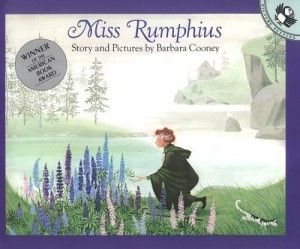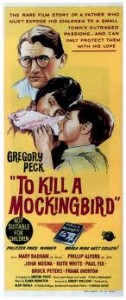Glen Huser’s Movie and Book Picks for August, 2011
My Book Pick: Miss Rumphius
My book pick for August is a picture book that I have loved over the years – Barbara Cooney’s Miss Rumphius (Viking, 1982). As a teacher-librarian for most of my life in elementary schools in Alberta, I made certain my shelves were stocked with books illustrated by Cooney – her Caldecott award-winning The Ox-cart Man (text by Donald Hall); Emma, chronicling the life of a Grandma-Moses type who takes up painting as an elderly woman; and her Year of the Perfect Christmas Tree, about an Appalachian family struggling to enjoy the midwinter holiday while worrying about Dad’s failure to return home following the armistice in World War I. Cooney, who died in 2000, left a heritage of her artwork in 110 books.
Of all of the books she illustrated, Miss Rumphius is my favourite – and it is one that Cooney declared connected in a biographical way to her own life. We meet Alice Rumphius as a little girl at the beginning of the book, helping her grandfather with his paintings:
In the evening Alice sat on her grandfather’s knee and listened to stories of faraway places. When he had finished, Alice would say, “When I grow up, I too will go to faraway places, and when I grow old, I too will live by the sea.”
“That is all very well, little Alice,” said her grandfather, “but there is a third thing you must do.”
“What is that?” asked Alice.
“You must do something to make the world more beautiful,” said her grandfather.
“All right,” said Alice. But she did not know what that could be.
In the meantime Alice got up and washed her face and ate porridge for breakfast. She went to school and came home and did her homework.
And pretty soon she was grown up.
Miss Rumphius becomes a librarian, and then we follow her on her travels to faraway places. Growing old, she finally settles in a little cottage by the sea, but she worries about what she might do to make the world a more beautiful place – that is, until she realizes that the lupines she has been planting have been spread beyond her garden, making wonderful splashes of color. Recovered from an illness, she makes it her mission to sew lupine seeds along the roads and fields, around the schoolyard, behind the church…
A few years ago, I moved with my parents and my sister to a new home in Edmonton. My father was failing with Alzheimer’s, and we were rallying to help look after him. The former owners of the house had been avid gardeners and, with the coming of spring and summer, I was thrilled to find the back garden lush with lupine flowers. Something of a sign, I believed. We grieved for my father’s gradual slipping away from us, but the lupines reminded me that he had done wonderful woodcarvings – in his own way making the world a more beautiful place.
Following my father’s death, moving to a co-op in Vancouver, I was invited over to have tea with one of the elderly co-op members. As we sipped our Earl Grey I listened to her recounting her life adventures – as a little girl taken by her grandfather down to the docks to see the great ships, and then of her career of working aboard commercial sea vessels and traveling to faraway places.
“I have a book I think you’d enjoy reading,” I told her as I was leaving. “I’ll drop it by.”
A couple of days later, she phoned me and said, “Is there any way I can get a copy of this book for myself? I absolutely love it.”
So I gave her my copy. I think Barbara Cooney’s works, like lupine seeds, should be spread.
 My Movie Pick: To Kill a Mockingbird
My Movie Pick: To Kill a Mockingbird
The impact that a wise adult can have on a child is borne out in my movie pick for August – To Kill a Mockingbird. Atticus Finch also has his gaze fixed on what we might do to make the world a more beautiful place in which to live.
For as long as I can remember, I have been fascinated by the process of transcribing the written word into film. As a teenager in the days before video tapes and DVDs, I had very limited access to movies, but I read books about them and I tracked down the stories – which were available in the stacks of the downtown Edmonton library and read them in anticipation of someday being able to see the movies made from them – Vicki Baum’s Grand Hotel, George Martin’s Our Vines Have Tender Grapes, Samuel Hopkins Adams’ “Night Bus” (which served as the basis for It Happened One Night), Richard Llewellyn’s How Green Was My Valley, Betty Smith’s A Tree Grows in Brooklyn…to name a few.
When Harper Lee’s To Kill a Mockingbird was published in 1960, I fell in love with the novel and could hardly wait to see whether or not a film version might capture the same magic. I was not disappointed. In fact, it was hard to imagine a more perfect transcription of text to film. For once, the moviemakers seemed to get everything right. Could anyone else other than Gregory Peck have portrayed Atticus Finch with the same authority?
Harper Lee herself, in an interview with Ron Newquist in the early 1960s, stated: “I’d never seen Mr. Peck, except in films, and when I saw him at my home I wondered if he’d be quite right for the part. The next time I saw him was in Hollywood when they were doing tests for the film. They put the actors in their costumes and slam them in front of the camera to see if they photograph correctly.
“They did Mr. Peck’s test on the lot on the little street where the big set had been erected, and the first glimpse I had of him was when he came out of his dressing room in his Atticus suit. It was the most amazing transformation I had ever seen. A middle-aged man came out. He looked bigger, he looked thicker through the middle. He didn’t have an ounce of makeup, just a 1933-type suit with a collar and a vest and a watch and a chain. The minute I saw him I knew everything was going to be all right because he was Atticus.”*
But it wasn’t just Atticus that director Robert Mulligan aced in choosing his cast. It’s pretty well spot on throughout and Mary Badham’s depiction of Scout seems so effortless and true that, with each viewing, I find myself shaking my head with the wonder of it. I had a chance to hear Mary Badham talk about the film following a screening at the Turner Classic Film Festival in April, and she indicated that Mulligan’s approach with the children (Phillip Alford plays Jem and John Megna plays Dill) was to have them “play” scenes as if they were, in fact, child’s play.
Badham indicated that she believes the film’s enduring popularity resides in the timeless message it conveys about what it means to be human and caring about our fellow beings. The book and film emerged at a time when the civil rights struggle was at its most intense in the Southern States. I can’t help wondering if it was, in its own way, as moving a force in the advocacy of equal rights and acceptance of all people as the marches and boycotts.
A good part of Harper Lee’s gift, that translates so beautifully to film, is the humour that we find in Scout’s behavior – and in her voice. Working with teachers in training over the years, I have often shared the sequence in which Scout complains about her first days at school in grade one with the teacher insisting that Scout has been taught the process of reading incorrectly, insisting that she learn to sound out the words (even though she is already a fluent reader). Very funny!
As a couple of final notes in my song of praise for this film, I have to commend producer Alan J. Pakula’s and Robert Mulligan’s decision to film in black and white – so right for the Depression-era period (and Boo Radley’s ghostlike emergence at the end of the picture). And Elmer Bernstein’s music – minimal and exquisite with a childlike simplicity.
If you haven’t watched To Kill a Mockingbird recently, give yourself a treat. It’s a film I probably view at least once a year.
*You can read the full Harper Lee interview at: http://www.thebluegrassspecial.com/archive/2010/july10/harper-lee-interview.php

